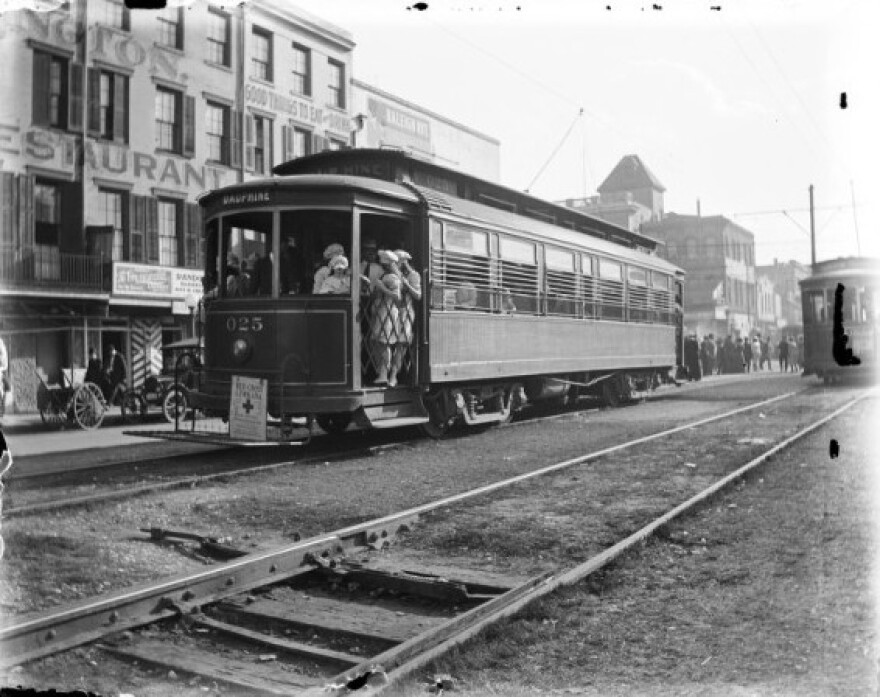Streetcars are an iconic part of New Orleans’ history, but they’re also a very real part of the transportation system. The city is investing more in the system, with a new Rampart Street line under construction.
The Regional Transit Authority says the new line will spur business and job growth, but local riders wonder if a streetcar is really the best way to get them to and from work – or if it’s more for tourists.
These days, a drive down North Rampart Street is rough. Drivers must deal with uneven pavement, dust storms, and strange traffic patterns.
Construction on the new Rampart streetcar line is halfway finished. And not only that, it’s expected to be done on time: slated to open in summer 2016. Patrice Mercadel is a spokesperson for Transdev, the private company contracted by the RTA to run its operations. She believes in the streetcar.
"We are sitting in New Orleans, Louisiana. Streetcars are a rich history for us," says Mercadel. "They provide an economic engine… for those communities that we build streetcar lines in."

But what’s that engine powering? A tourist economy or other types of jobs? The Rampart streetcar line is an extension of the Loyola line, which opened in 2013. The Loyola line cost $60 million in public funds. Mercadel says that led to $2 billion in private investment in the six block radius around the downtown line.
And streetcars aren’t just nostalgic. Atlanta, Dallas and Kansas City have installed streetcars in recent years to cut traffic and spur downtown development.
But static streetcar lines don’t meet all commuters’ needs. Keli Rylance lives in New Orleans' Seventh Ward, and works Uptown at Tulane. She says her commute was better before the Loyola streetcar.
"I took the Jackson/Esplanade, the Number 91. It’s known locally as the Cemeteries Bus, and I would usually get off the bus on Baronne Street near where the new Rouse’s is, and I would transfer to the Number 15 bus, which is the Freret Street bus -- or the Freret Jet as it’s commonly called."
But when the Loyola line went in, the Freret Jet was rerouted to the Union Passenger Terminal. That change doubled her commute.
"Before, what was an acceptable time of 45 minutes, to go five miles, all of a sudden became an hour and a half to two hours for my daily commute. If it takes an hour-and-a-half using the transit system to travel five miles, you’d actually be better off walking."
Keli has stopped using public transit. She has a car. She rode the bus by choice. But not everyone has options. The new Rampart line will change bus routes, just like the Loyola line did. Transdev doesn’t have the details just yet. But Patrice Mercadel argues the new streetcar does have workers in mind.
"We’re looking at bringing those streetcar lines back there and generating that same economic boom in those traditional New Orleans historic neighborhoods," she says.

The North Rampart line could extend all the way down St. Claude to Press Street or beyond, going deeper into residential areas.
Rachel Heiligman heads RIDE, a transportation advocacy group. She says those neighborhoods are already served by bus. RIDE says the RTA can get more bang for its buck if it adds regional transport. Focusing on the streetcar, she says, prevents that.
Take suburban Elmwood, one of the largest job centers in the state. Workers have a hard time getting to the industrial and service jobs there.
"They have to ride multiple transit systems, pay multiple fares. That should be an easy commute," she says. "So should the River Parishes region, where we’ve got 40,000 jobs coming on line that are well paying jobs that can be accessed easily with limited education."
The RTA has a budget surplus this year, and plans to use that to expand bus service. Later hours and more routes in New Orleans East, the Westbank and the Lower 9th Ward. It’s also working on a master plan for the next 20 years of all public transportation -- not just streetcars -- in New Orleans.



